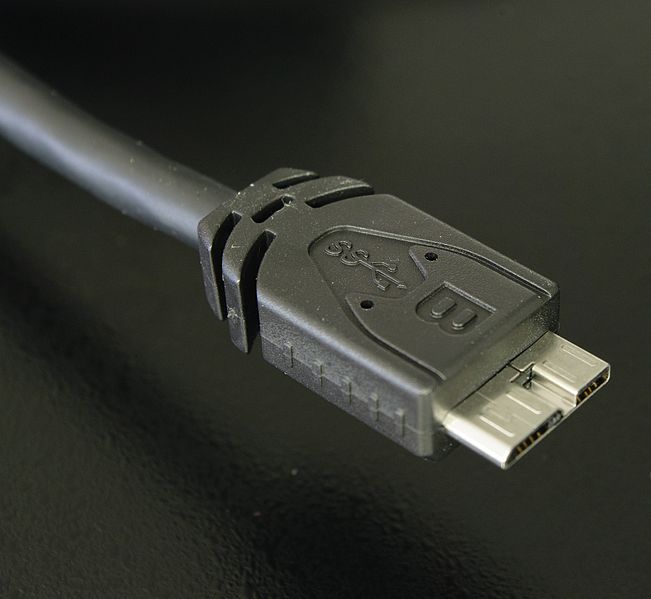USB 3.0 is the third major revision of the Universal Serial Bus
(USB) standard for computer connectivity. In the late 1990s, the first
major revision was made to the USB 1.1 specification. The revision was
called USB 2.0 which added a new transfer speed called High Speed (HS –
480 Mbit/s) to the earlier speeds (Low Speed (LS) – 1.5 Mbit/s and Full
Speed (FS) – 12 Mbit/s).
The USB 3.0 specification uses the same concepts of USB 2.0 but with
many improvements and totally different implementation. Earlier USB
concepts like endpoints and four transfer types (bulk, control,
isochronous and interrupt) are preserved but the protocol and electrical
interface is significantly different. It is so different that the
specification defines a physically separate channel to carry USB 3.0
traffic. The changes in this specification make improvements in the
following areas:
transfer speed – added a new transfer type called Super Speed or SS – 5 Gb/s (electrically it is more similar to PCIe Gen2 than USB 2.0)
more bandwidth – instead of one-way communication, USB 3.0 uses two unidirectional data paths: one to receive data and the other to transmit.
power management – U0 through U3 link power management states are defined.
improved bus utilization – a new feature is added (using
packets NRDY and ERDY) to let a device asynchronously notify the host of
its readiness (no need of polling)
support to rotating media – Bulk protocol is updated with a
new feature called Stream Protocol that allows a large number of logical
streams within an Endpoint.
USB 3.0 has transmission speeds of up to 5 Gbit/s, which is 10 times
faster than USB 2.0 (480 Mbit/s). USB 3.0 significantly reduces the time
required for data transmission, reduces power consumption, and is
backwards compatible with USB 2.0. The USB 3.0 Promoter Group announced
on 17 November 2008 that the specification of version 3.0 had been
completed and had made the transition to the USB Implementers Forum (USB-IF), the managing body of USB specifications.[1] This move effectively opened the specification to hardware developers for implementation in future products.
The first USB 3.0 consumer products were announced and shipped by Buffalo Technology in November 2009, while the first certified USB 3.0 consumer products were announced January 5, 2010, at the Las Vegas Consumer Electronics Show (CES), including two motherboards by ASUS and Gigabyte Technology.[2][3]
Manufacturers of USB 3.0 host controllers include, but are not limited to, Renesas Electronics, Fresco Logic, Asmedia, Etron, VIA Technologies, Texas Instruments, NEC and Nvidia. As of November 2010, Renesas was the only company to have passed USB-IF certification, although Fresco Logic has now[when?] also passed USB-IF certification. Motherboards for Intel's Sandy Bridge processors have been seen with Asmedia and Etron host controllers as well. On October 28, 2010, Hewlett-Packard released the HP Envy 17 3D featuring a Renesas USB 3.0 host controller several months before some of their competitors. AMD worked with Renesas to add its USB 3.0 implementation into its chipsets for its 2011 platforms.[dated info] At CES2011, Toshiba unveiled a laptop called "Toshiba Qosmio X500" that included USB 3.0 and Bluetooth 3.0, and Sony released a new series of Sony VAIO laptops that will include USB 3.0. As of April 2011, the Inspiron and Dell XPS series are available with USB 3.0 ports.
Architecture and features In USB 3.0 dual-bus architecture is used to
allow both USB 2.0 (HIGH Speed/LOW Speed/FULL Speed) and USB 3.0 (Super
Speed) operations to take place simultaneously, thus providing backward
compatibility. Connections are such that they also permit forward
compatibility, that is, run USB 3 devices on USB 2.0 ports. The
structural topology is the same, consisting of a tiered star topology
with a root hub at level 0 and hubs at lower levels to provide bus
connectivity to devices.
Data transfer and synchronization The SuperSpeed transaction is
initiated by the host making a request followed by a response from the
device. The device either accepts the request or rejects it. If accepted
then device sends data or accepts data from the host. If the endpoint
is halted, the device shall respond with a STALL handshake. If there is
lack of buffer space or data, it responds with a Not Ready (NRDY) signal
to tell the host that it is not able to process the request. When the
device is ready then, it will send an Endpoint Ready (ERDY) to the host
which will then reschedule the transaction.
The use of unicasting and the limited multicasting of packets,
combined with asynchronous notifications, enables links that are not
actively passing packets to be put into reduced power states, allowing
for better power management.
Data encoding The "SuperSpeed" bus provides a transfer mode at
5.0 Gbit/s additionally to the three existing transfer modes. The raw
throughput is 4 Gbit/s, and the specification considers it reasonable to
achieve 3.2 Gbit/s (0.4 GB/s or 400 MB/s) or more.
All data is sent as a stream of eight bits which are scrambled and then converted into 10-bit format. This helps to reduce electromagnetic interference (EMI). The exactly opposite process is carried out at the receiving end. Scrambling is implemented using a free running Linear Feedback Shift Register (LFSR). The LFSR is reset whenever a COM symbol is sent or received.
It is still going to be tethered to 16 feet (maximum) cables with
active repeaters for extended lengths. So far, USB 3.0 still runs on
copper cabling with most likely the same inherent limitations.[4]
source : wikipedia.org
Anda mungkin menyukai postingan ini
Popular Posts
Subscribe Us

Blog Archive
Cari Blog Ini
Labels Cloud
Labels List
Facebook Like
Footer Menu Widget
Designed with by Way2Themes | Distributed By Hire Blogger Designer



0 Komentar